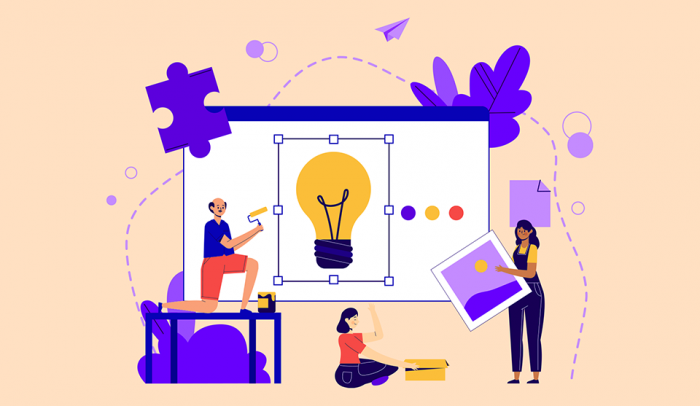Welcome to Part III of our series on using content marketing to replace leads lost due to the coronavirus pandemic. If you missed our first two parts, get caught up here: Part I and Part II.
Step 5: Optimize your expertise
Consumers are hungry for information and educational experiences. The more useful you can make your content, the more likely it is you will attract high-quality leads and be able to nurture them. Set your educational content apart with your delivery—using stimulating, interactive elements to keep your audience engaged. Here are some ideas to turn your practical, useful content into exciting experiences.
Expand your audience with a podcast
It’s estimated that 90 million Americans listened to a podcast in the last month—that’s over 30% of the population. And 41% of monthly listeners make over $75,000 in yearly salary. By 2021, the podcasting industry is expected to make $1 billion in revenue. Podcasting gives you the opportunity to connect with a new audience, and for a more powerful bond with your existing audience, so it’s hard to imagine why you shouldn’t give it a try.
We’re not suggesting that it’s easy to build an audience—cultivating listenership for a podcast takes a lot of time and a ton of dedicated effort. But podcast audiences tend to be extremely loyal and depend on regularly updated audio streams as part of their routine. Here are some things to keep in mind as you try to fold a podcast into your existing content strategies.
- Stick to a simple setup: All you need is a microphone and an audio-editing software like GarageBand or Hindenburg to cut out the vocal tics.
- Pick a format: Use your podcast to leverage your company’s visibility in your industry. Invite experts from other companies—even your clients—to engage in informative conversations that ideally shed a little light on what they do.
- Pick a defined insider topic: There should be a somewhat narrow overall theme to the podcast, something that might be adjacent to the services that your company provides. In each episode you can dive into specifics. Remember that your audience will be willing to listen to over an hour’s worth of content if they feel like they’re learning something valuable.
Your podcast doesn’t have to be a perfect representation of your company—nor does it have to be approached as a perfect marketing tool. It’s really just one more avenue through which you can gain access to an audience that’s waiting for you, and gain their trust through your smart industry insight.
Webinars are a golden opportunity
If it’s true that what consumers want most right now is educational content, then webinars are going to be your greatest asset. Digital presentations and webinars should be at the forefront of your new digital marketing strategy. It’s time to abandon the old talking head model that you relied on in the past—focus on making your webinars immersive, multimedia experiences. Here are some ways to approach them with interactivity in mind.
- Promote early and often: Webinars are a wonderful way to generate leads, but to get the best results, you have to know exactly when and how to promote it. GoToWebinar found in a survey that over half of all webinar registrations happen the week of, and that 36% of registrations happen between 8-10am—more than half of them coming from email. So email a week before, as well as the day of your webinar, to generate the highest attendance.
- Pick an engaging format: Add a little excitement—and give your hosts more opportunities to break script—by making your webinar more of a conversation than a presentation. In order to pull this off, you’re going to need more than one host. There are a few alternative formats to choose from. You could try an interview-style webinar, a Q&A with an expert, or a panel discussion with numerous guests.
- Host a winning digital presentation: Audiences will sit through a lot, as long as they believe that they’re getting something useful out of their experience. That’s part of the reason that the majority of webinars last upwards of 60 minutes. There are some simple techniques that will make your presentation even more successful and they’re all about strong delivery. Speak conversationally. This will help maintain an ambience of intimacy, and help keep your audience engaged with what you’re saying.
- Incorporate dynamic elements: Break the conversation up into narrow, clearly defined segments, and pepper them with interactive, engaging features. That might mean infographics, polls, chat conversations, audience surveys, live Q&As, and videos. The more interactive, the more engaged your audience will be.
- Nurture those leads immediately: The webinar doesn’t end when the presentation is over. That’s your cue to start nurturing those high-quality leads that you just identified and interacted with during the live experience. Send out a follow-up email within 24 hours of the webinar. Make it as personalized as possible, using the data you collected during the live experience to segment your audience by industry and interest. Here’s a tip: consider using a poll midway through your webinar to identify who might be ready to be contacted by a sales representative.
- Remember, it’s not just about the live experience: Over a quarter of webinar attendees don’t participate in the live experience—they prefer to watch it after the fact. Be sure to record your presentation, and do everything you can to make the content evergreen and engaging for that future audience.
Turn your digital presentations into virtual events
Once you can properly host one webinar or panel discussion, you know you can produce many, turning them into larger and more immersive events. Here are a few other things to keep in mind as you plan your virtual event:
- Have very clear goals: You should have clear objectives for every marketing initiative you take, but for a virtual event, which takes so much time and effort to prepare, it’s very important to have a specific goal and message. Are you going to launch a particular product? Are you announcing a new partnership? Whatever it is, make sure you begin the venture with clear measurements of success.
- Bigger isn’t always better: Remember how much effort goes into that one digital presentation. Production takes time, and outreach and promotion take a great deal of time, too. Start small, and grow from there. Remember: if the ultimate goal is to generate high-quality leads, careful and diligent planning of focused events can achieve that.
- Give yourself plenty of time to prepare: Think of the effort associated with an event as a long play: it extends back to the previous year and goes forward into the future. It takes a lot of time to reach your audience and generate excitement for your digital event. Remember that the content you create for the event will have a much longer shelf life than just the event itself.
- Pick the right partners: Conferences are a great way to bolster your media relations, and to get your influencers and brand ambassadors creating content for you that can be used long into the future.
- Find ways to encourage networking: The key difference between a webinar, and a conference is networking. Find ways to encourage your audience members to get to know each other. Organize break-off rooms and small gatherings for select participants to meet and share stories.
- Don’t forget the swag: Gifts and sample products work just as well in-person as they do at a distance. Have your attendees volunteer some information about themselves in exchange for a hat—or even a sample. This is a great way to get your product in the hands of possible consumers, identifying micro-influencers, and helping to generate case studies and consumer reviews, which can be used as part of your video strategy (see Step 4).
Step 6: Boost your social presence
In your quest to generate leads, go back to the top of the marketing funnel, and focus on some ways to increase brand awareness.
There’s a debate in the marketing world about the relationship between social media marketing, brand awareness, and lead generation. Not all marketers agree on social media’s impact on search engine rankings. Can you improve your Google rank by posting more on your LinkedIn page? While there doesn’t seem to be a direct relationship—your positive social engagement doesn’t necessarily have any impact on SEO—a few studies show a correlation between them.
That suggests that the more content you make, the more users will notice you, whether the content lives on your social channels or on your blog.
Part of the reason for this is that search engines still basically work on a citation model. That means that the more pages that reference your content, the more likely overall that users will wind up on your pages. Here are some ways to ensure that your social strategy is geared toward positive lead generation.
Use social media to source ideas
Social media are great platforms for promotion, but that’s not their only use. Each platform has its own distinct audience which engages in unique conversations. To really get the most out of social media, B2Bs should grow more comfortable connecting with these audiences in a more personable fashion—not with sales in mind, but rather just for the sake of authentic, empathetic engagement.
Relaxing the brand voice on social channels
Once your social channels are no longer exclusively spaces for promotion, experiment and explore adopting aspects of your company’s brand to a new voice, one that’s more fitting for the given channel.
Right now, that conversation is happening on Twitter. Influencer Marketing Hub has reported that 34% of marketers have shifted their attention from Instagram to Twitter. Instagram use by brands in 2020 has dropped by 14%, and Facebook isn’t far behind at a 13.5% decrease. The reason for this drop makes practical sense—Twitter is a great platform for news content.
Because of its simple, self-contained format, Twitter is also a great platform to experiment with brand voice and messaging. Try to meet consumers’ preferences for authentic, empathetic, and truthful messaging by stepping away from the sales pitch and toward a voice that’s as human as the marketer who’s drafting those tweets.
What influencer-led campaigns of the future will look like
In keeping with the trend toward truthful and authentic messaging, influencer-led campaigns are going to grow in importance in 2020. Here are some trends to look out for.
- Platform diversity: Right now, Instagram—specifically Instagram Stories—is the clear platform of choice, with 75% of influencers saying it’s their preferred platform. But Twitch, TikTok, and Twitter are all making headway this year.
- The rise of micro-influencer: The traditional influencer is losing favor. That’s because sponsored content isn’t just about impressions, it’s about the quality of those impressions. Micro-influencers and micro-interactions are what matter—exerting great influence on their smaller followings of like-minded contacts and friends. One issue with building out a micro-influencing strategy is that the right spokespersons can be hard to find. Start your search within the ranks of your company. If there’s anyone who currently works for you with a sizable social following and would like to speak articulately to the benefits of your business, then that’s the perfect place to begin.
- Unexpected and versatile partnerships: While 68% of marketers prefer influencer marketing to be campaign-based, other styles of influencing—more flexible forms of brand ambassadorship—are growing in popularity. This blurring role of the influencer in some cases gives them more control to make their own business decisions, and determine how they use their influencer status to the best of their ability.
Going live on LinkedIn and Facebook
Make your social platforms the center of your educational strategy, and start hosting your webinars and digital presentations on Facebook and LinkedIn, where your audience is spending their days. Because these social platforms are casual and accessible, you can jump right into engaging conversations with your audience. It’s an exciting way to showcase a new product, launch a new campaign, or reveal a new company partnership.
In terms of popularity, LinkedIn is on the rise: engagement on the platform increased 50% year over year, with 94% of B2B marketers using it for content marketing purposes. Live videos receive 24x more comments and 7x more reactions than a native video posted to LinkedIn does. B2Bs have had success with serial, weekly formats, like the software company Gong’s new series on working from home, as well as on-time live events, like the kick-off to the Microsoft Build conference.
Facebook Live is another great opportunity for video content—users are 4x more likely to watch a live video than a native video—but the platform has a slightly different demographic. Nearly 70% of all U.S. adults use Facebook, but in terms of the population breakdown, users skew older, and are majority women. The benefits of going live are still great for raising brand awareness, it just depends on your product and the market you’re trying to reach.
This post is the third of a four-part series on replacing lost leads from the coronavirus pandemic with content marketing. If you’re ready for Part IV, click here!



